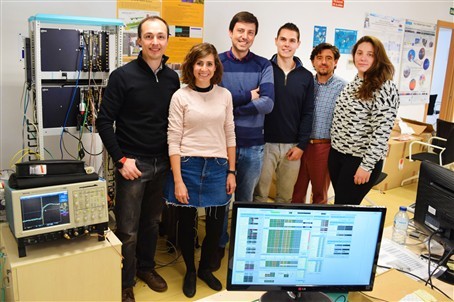Seven solutions develops software and hardware that enhance the operation of accelerators

The team of Seven Solutions involved in the development of equipment for the IFMIF-EVEDA projects of the Broader Approach Agreement, signed between Europe and Japan.
Granada takes pride in its majestic heritage. The city exemplifies Spain’s cultural richness and diversity. Over the years, it has built its reputation as a destination which has a lot to offer to those who are fascinated by history, architecture, and who enjoy life in the slow lane. But beneath the sun-kissed roofs of this picturesque city, which resembles to a postcard from the past, lies a vibrant community of researchers, engineers and physicists who are eager to change the future quickly. They are discreet, hard-working and above all committed.
Almost 12 years ago, with the financial support of the European Union, Seven Solutions was set up. The small company, counting seven founders as their workforce at the time, brought together academics from the University of Granada and few of their graduates who wished to pursue a career in Big Science projects. They all had a technical background and promised to look for solutions in the fields of physics and astrophysics. Naturally, projects managed by CERN (Switzerland) or ESA (Paris) were in line with their field of expertise. Fusion projects building on transnational collaboration, like the Internationa
l Fusion Materials Irradiation Facility (IFMIF) bringing together Europe and Japan, were also on their radar. And while many get cold feet about playing a role in large projects because they feel they are out of their league, Seven Solutions plucked up more confidence and offered their skills.
Today the company counts 38 employees and has recently opened offices in the US and in Germany. How did they manage to defy all odds and to add to their list of success stories radiofrequency equipment for accelerators, software and firmware which will enhance their operation by measuring with high precision the beam energy and its position?
Miguel Mendez, one of the first employees of Seven Solutions, and Head of High Energy Physics, recently visited F4E to sign a licence agreement. The company will be allowed to explore the commercial potential of the hardware and software they developed, which is used in LIPAc – a prototype accelerator which is part of IFMIF. The results of this project will feed into DONES, the DEMO Oriented Neutron Source, which is planned to operate in Granada.

The company enjoyed its first big break with CERN. They developed time transfer and synchronisation devices for large control systems. The technology they used is known as White Rabbit . It can synchronise devices in sub-nanosecond time transfer. Seven Solutions brought this technology to industry with the design of the first switch which included this feature. The company continued to demonstrate its expertise in various projects, and after building a partnership with CIEMAT they targeted IFIMIF. They offered to deliver hardware and software using White Rabbit technology in order to make the system operate more precisely. They were selected by F4E, co-ordinating Europe’s contribution to IFMIF, and have so far signed three contracts. When the first piece of hardware was successfully installed, the need for new functionalities and further optimisation was identified. The engineers wanted to boost the overall performance of the system for the high power supply amplifiers and in parallel increase its safety.
“We developed software which could be universally used with accelerators improving the overall operation of their systems, their timing distribution and safety. LIPAc is state-of-the-art equipment and we had the privilege to run the software there for the first time. The results have been positive. Overall, we wanted to improve the Radio Frequency (RF) control system devices by introducing novel features which take advantage of this ultra-accurate synchronisation technology. They succeeded in distributing the RF, controlling and measuring with precision the beam energy and its location. This qualified as a breakthrough. In essence we have a new and innovative product in the market. Initially, three people were involved in this project and currently there are five working full-time and three working part-time due to the increasing volume of work. The development of this software has opened us the door to high-energy physics and to projects such as ITER , the ESS or experiments using RF control systems. It may also be of relevance in medicine, where accelerators are also being used for cancer therapy,” Miguel Mendez explains.

The company was set up as a start-up, building a bridge between academia and enterprise. The founders are firm believers that both public and private entities can mutually help one another by investing in R&D and by taking a commercial risk they can have an impact in the market. “The technically demanding environment in fusion has created the need for further advancements. We, at F4E, encourage our industrial partners to push forward know-how because it also raises the prospect for spin-offs. The case of Seven Solutions beautifully demonstrates how an SME, with a proven-track record in its domain, took a step forward by joining an international project, grew in terms of expertise and is now ready to be launched in the market,” says Gebhart Leidenfrost, F4E’s Chief Financial Officer in charge of commercial activities.